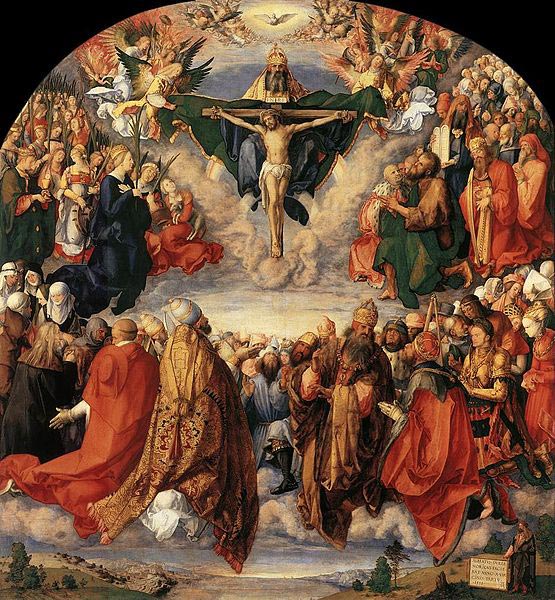| Adoration of the Trinity | |
|---|---|
 |
|
| Artist | Albrecht Dürer |
| Year | 1511 |
| Medium | Oil on poplar panel |
| Location | Kunsthistorisches Museum, Vienna |
| Dimensions | 53 in × 48 in |
| 135 cm × 123 cm | |
| Famous Paintings by Albrecht Dürer | |
| Young Hare | |
| Rhinoceros | |
| Adam and Eve | |
| Praying Hands | |
| Knight, Death and the Devil | |
| Apocalypse | |
| Self-Portrait of Albrecht Dürer | |
| Melencolia I | |
| Adoration of the Trinity |
Adoration of the Trinity by Albrecht Dürer is a work of religious iconography painted between 1509 and 1511 A.D. It is an oil on wood panel painting meant to serve as an altarpiece painting in a chapel.
Description
The oil painting measures 53 inches by 47 inches with an arch-shaped top. In the top center is Christ crucified, with a Father God figure behind and above him. Above the Father God’s head is a white dove surrounded by light. Surrounding the Trinity figures are a host of angelic beings. To the left of Christ’s feet is the Virgin Mary and a large group of female saints holding palms. To the right are male saints, including Moses with the tablets of the Commandments. Below the saints, other women and men are shown worshiping God. All this is depicted in a rent in mid-air.
In the lower right hand corner on the earth beneath the heavenly scene, a small figure of Albrecht Dürer stands looking out at the viewer. He points to a plaque beside him inscribed with “Albrecht Dürer of the North made this in the year of the Virgin 1511.”
Technique
Panel oil painting is one of the oldest forms of fine art painting. It was highly popular until the mid-16th century, when canvas became more common. Dürer used poplar for this altarpiece, an unusual choice in a region where artists usually used oak. The painting is made with bright oil pigments, standard practice for religious art during the period.
Background and History
Custom altarpieces were highly sought after for churches and chapels. These paintings often contained portraits of the artist’s patrons and benefactors. Adoration of the Trinity was commissioned for the chapel at the “House of the 12 Brothers”, a retirement home for aged artists. Dürer’s patron, Mäthaus Landaur, appears in the painting.
As is typical of Dürer’s work, Adoration of the Trinity contains many allegorical figures. Scholars agree that the work reflects an Augustinian world view. It is now housed in a museum in Vienna.